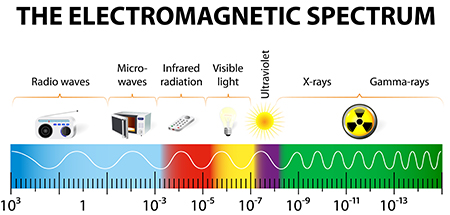Learn

Electromagnetic Radiation
In the last lesson we discussed electromagnetic waves, which were transverse waves that were composed of an electric field and a magnetic field oscillating back and forth. It’s now time to look at another definition that goes along with electromagnetic waves which is electromagnetic radiation.
Electromagnetic radiation is simply a form of energy that is primarily composed of electromagnetic waves. Since electromagnetic radiation is composed of electromagnetic waves, this means any wave on the EM spectrum is an example of electromagnetic radiation including: radio waves, microwaves, infrared, visible light, x-rays, and gamma rays.

The electromagnetic spectrum
Chances are you have heard the term "radiation" used at some point (possibly in a movie or TV show), and it referred to as something dangerous or harmful. While there are definitely forms of electromagnetic radiation that are harmful, many forms are not.
In fact, electromagnetic radiation is everywhere! You are exposed to it on a daily basis. Electromagnetic radiation like sunlight is essential to grow plants and provide energy to sustain life.
Watch the following video on Everyday Radiation (1:46) to look more closely at some everyday sources of radiation. PBS login information.
While many sources of radiation are not harmful, others can be incredibly harmful to the environment and us. Use the next two tabs to explore more about types of radiation.

Ionizing Radiation
There are two subdivisions of electromagnetic radiation.
- Ionizing radiation
- Non-ionizing radiation
Longer frequency waves are non-ionizing, whereas shorter waves are ionizing.
Ionizing radiation is energy in the form of particles or waves.
Ionizing radiation is so high in energy it can break chemical bonds. This means it can charge (or ionize) an atom that it interacts with by impacting the electrons.
- At a lower energy, it may strip off some electrons.
- At a higher energy, it can destroy the nucleus of an atom.
This means that when ionizing radiation passes through the tissues of the body, it actually has enough energy to damage DNA. This is why gamma rays are used to destroy cancer cells through radiation treatment.
The following give off ionizing radiation:
- radioactive material
- very high-voltage equipment
- nuclear reactions
- stars
This is quite a variety, so you can see that ionizing radiation can be both natural and man-made. A natural source of ionizing radiation is radon, a radioactive material found underground. X-rays are a good example of man-made ionizing radiation.
Learn more by watching the video Radon Radiation (1:46). PBS login information.

Non-ionizing Radiation
Non-ionizing radiation is relatively low energy radiation that does not have enough energy to ionize atoms or molecules. They are located at the low end of the electromagnetic spectrum.
Examples of non-ionizing radiation sources include:
- power lines
- microwaves
- radio waves
- infrared radiation
- visible light
- lasers
Although considered less dangerous than ionizing radiation, overexposure to non-ionizing radiation can cause health issues.
Open and review the Electromagnetic Radiation Spectrum. This complex graphic will allow you to compare ionizing and non-ionizing radiation and the sources and uses of these different frequencies and band widths. Think of what technology you're around every day. What kinds of radiation are those devices emitting?
Next, open the Scientific American article Bombarded: Electromagnetic Radiation of Our Own Making Fills the "Empty" Air and review the graphic carefully to explore our daily exposure to non-ionizing radiation from cell phones and other electronic devices.
You may want to bookmark these two images for later use in your research.

